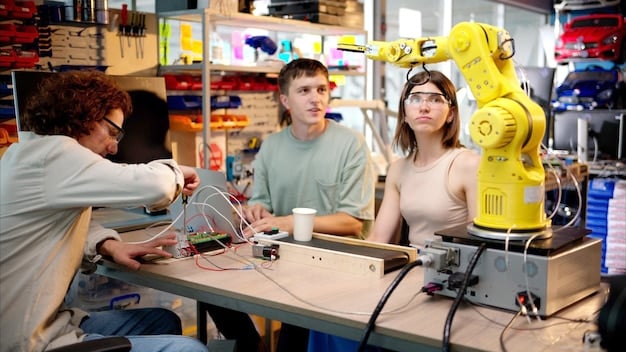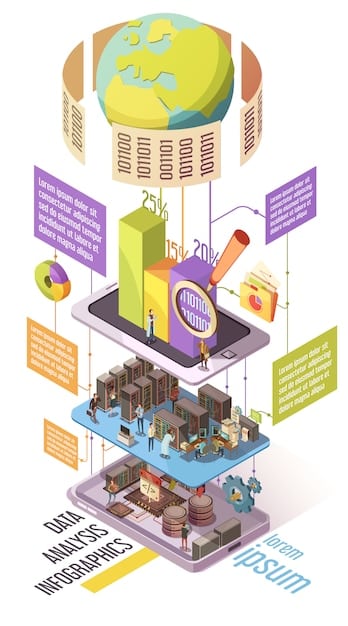US Robotics Education Future: Preparing for 20% Job Growth

The future of US robotics education is currently undergoing a transformative shift, aligning curricula with industry demands to cultivate a workforce capable of capitalizing on the projected 20% increase in robotics-related jobs, emphasizing practical skills and interdisciplinary learning for sustained economic growth.
The landscape of education within the United States is continuously evolving, particularly in high-growth sectors. One such sector poised for significant expansion is robotics. Understanding The Future of US Robotics Education: Preparing Students for a 20% Increase in Robotics Jobs is crucial for educators, policymakers, and students alike, as the nation prepares to meet the demands of an increasingly automated world.
The Evolving Landscape of Robotics in the US
The United States stands at a pivotal juncture where technological advancements in robotics are rapidly reshaping industries and creating new economic opportunities. This transformation is not merely about automation, but about a symbiotic relationship between human innovation and robotic capabilities. The projected 20% increase in robotics jobs is a clear indicator that this field is becoming an indispensable part of the national economy. This growth permeates various sectors, from manufacturing and healthcare to logistics and agriculture, demanding a workforce equipped with specialized skills and adaptable knowledge.
The traditional view of robotics, often confined to heavy industrial machinery, has expanded significantly. Today’s robotics encompasses sophisticated artificial intelligence, machine learning, computer vision, and advanced materials. This diversification means that the demand extends beyond engineers to include data scientists, ethical AI specialists, human-robot interaction designers, and skilled technicians. The complexity of these roles necessitates a more comprehensive and interdisciplinary educational approach, moving beyond siloed disciplines to foster holistic understanding.
Bridging the Skills Gap
A primary challenge in this evolving landscape is the persistent skills gap. While the demand for robotics professionals is surging, the supply of adequately trained individuals often lags. This gap can hinder innovation and economic growth, making proactive educational reforms imperative. Educational institutions are increasingly recognizing this need, with many focusing on curricula that directly address industry requirements. This includes incorporating real-world projects, internships, and partnerships with leading robotics companies.
- Industry-validated curricula
- Practical, hands-on learning experiences
- Collaboration with robotics companies
- Development of soft skills alongside technical expertise
Addressing this gap requires a concerted effort from all stakeholders: government, industry, and academia. Government funding for STEM education, industry engagement in curriculum development, and academic institutions’ willingness to innovate are all critical components. The goal is to create a robust pipeline of talent, ensuring that the US remains competitive in the global robotics landscape.
The integration of robotics into daily life also brings ethical and societal considerations. As robots become more autonomous and pervasive, questions around job displacement, data privacy, and ethical decision-making become more pressing. Therefore, a comprehensive robotics education must also include a strong foundation in ethics, critical thinking, and societal impact. This ensures that the next generation of robotics professionals is not only technically proficient but also socially responsible.
Reimagining K-12 Robotics Education
The foundation for a robust robotics workforce begins long before college. Reimagining K-12 education to include comprehensive robotics programs is essential for cultivating early interest and foundational skills. This means moving beyond simple coding clubs to fully integrated, hands-on learning experiences that introduce students to the diverse facets of robotics. Elementary and middle school programs can focus on basic programming, mechanical principles, and problem-solving through playful, engaging activities. High school curricula can then delve deeper into more complex concepts, including advanced programming, circuit design, and even ethical considerations of AI.
This early exposure serves multiple purposes. It demystifies the field of robotics, making it accessible to a wider range of students, including those from underrepresented groups. It also fosters critical thinking, creativity, and collaborative skills—qualities that are invaluable in any future career path. By engaging students at a young age, educators can spark a passion for STEM fields that might otherwise go unnoticed.
Curriculum Integration and Teacher Training
Effective K-12 robotics education relies heavily on robust curriculum integration. Robotics should not be seen as a standalone subject but rather as a cross-cutting discipline embedded within science, technology, engineering, and mathematics (STEM) courses. For instance, a physics class could explore robotic locomotion, while a math class could use robotics to teach geometry and algebra. This interdisciplinary approach makes learning more relevant and engaging for students.
- Integrating robotics into existing STEM subjects
- Developing project-based learning modules
- Providing access to robotics kits and lab equipment
- Creating pathways for advanced study in high school
However, the success of these programs hinges on adequately trained teachers. Many educators, particularly at the K-12 level, may not have formal training in robotics or related fields. Therefore, significant investment in professional development and ongoing support for teachers is crucial. This includes workshops, online courses, and access to mentorship opportunities that equip them with the knowledge and confidence to deliver effective robotics instruction.
The development of national or state-level guidelines for robotics education can also provide a framework for schools. These guidelines can ensure a consistent standard of quality and help schools design comprehensive programs that align with future workforce needs. Additionally, fostering partnerships between K-12 schools and local universities or industry leaders can provide invaluable resources, mentorship, and real-world exposure for students. Such collaborations can bridge the academic and professional worlds, making the educational experience more impactful and preparing students for future career opportunities.
The aim is not to turn every student into a robotics engineer, but to ensure that all students have a foundational understanding of this transformative technology. This prepares them not only for direct careers in robotics but also allows them to thrive in an increasingly automated world, regardless of their chosen profession.
Higher Education’s Role in Advanced Robotics
Universities and colleges play a paramount role in shaping the future of US robotics education, particularly in preparing students for advanced research, development, and leadership positions crucial for a 20% increase in robotics jobs. Higher education institutions are where cutting-edge research unfolds, pushing the boundaries of what robots can achieve and developing the next generation of robotic systems. This involves not only engineering disciplines but also computer science, material science, cognitive science, and even humanities, considering the ethical and societal implications of advanced robotics.
The focus in higher education extends beyond foundational knowledge to specialized areas like human-robot interaction, autonomous systems, swarm robotics, and soft robotics. These sophisticated fields require rigorous academic training, access to state-of-the-art laboratories, and opportunities for interdisciplinary collaboration. Universities are uniquely positioned to offer this comprehensive environment, fostering a deep understanding of both theoretical principles and practical applications.
Specialized Programs and Research Opportunities
To meet the growing demand for highly skilled professionals, universities are increasingly developing specialized degree programs. These may include Bachelor’s, Master’s, and Ph.D. programs in Robotics Engineering, AI and Robotics, or Mechatronics. Such programs are often designed with industry input, ensuring that graduates possess the skills most sought after by employers. Many universities also offer dual-degree programs or certificate options, allowing students to tailor their education to specific career interests.
- Dedicated robotics engineering departments
- Interdisciplinary research centers
- Industry-sponsored capstone projects
- International exchange programs in robotics
Research opportunities are a cornerstone of advanced robotics education. Students often engage in faculty-led research projects, contributing to advancements in fields such as robot perception, manipulation, navigation, and collaborative robotics. These experiences not only enhance their technical skills but also develop critical thinking, problem-solving abilities, and the capacity for innovation. Many institutions also encourage entrepreneurship, supporting students who wish to commercialize their research through incubators and accelerators.
Furthermore, partnerships between universities and industry are vital. These collaborations can take various forms, including joint research initiatives, internships, co-op programs, and guest lectures from industry experts. Such interactions provide students with valuable real-world experience, expose them to industry best practices, and facilitate smooth transitions from academia to professional careers. These strategic alliances also ensure that academic training remains relevant to the evolving needs of the robotics industry, creating a synergistic ecosystem that benefits both students and the wider economy.
The aim is to produce not just skilled technicians, but visionary leaders capable of driving innovation, addressing complex challenges, and shaping the ethical trajectory of robotics technology. The emphasis on interdisciplinary study and practical application prepares students to be adaptable and influential in a rapidly changing technological landscape.
The Role of Vocational and Technical Training
Alongside traditional academic routes, vocational and technical training programs are indispensable for preparing students for the burgeoning robotics workforce, especially for the hands-on roles that support a 20% increase in robotics jobs. These programs typically focus on practical skills, preparing individuals for positions such as robotics technicians, automation specialists, and maintenance engineers. While university programs may concentrate on design and research, vocational training emphasizes installation, operation, troubleshooting, and repair of robotic systems.
These skilled trades are the backbone of industries adopting automation. As more businesses integrate robotics into their operations, the demand for personnel who can keep these complex systems running smoothly will only intensify. Vocational training offers a faster pathway to employment, often with industry certifications that validate specific competencies. This makes it an attractive option for individuals seeking to enter the workforce quickly or those looking to pivot careers into a high-demand field.
Hands-On Experience and Industry Certifications
The hallmark of effective vocational robotics training is extensive hands-on experience. Students learn by doing, working directly with industrial robots, programmable logic controllers (PLCs), sensors, and other automation equipment. Training often takes place in simulated factory environments or dedicated labs, allowing students to practice real-world scenarios. This practical approach ensures graduates are immediately effective upon entering the workforce, minimizing the need for extensive on-the-job training.
- Intensive lab work and practical exercises
- Use of industry-standard equipment
- Focus on troubleshooting and maintenance
- Alignment with current manufacturing practices
A critical component of vocational training is the acquisition of industry certifications. These badges of competency are often developed by equipment manufacturers or industry associations and serve as official recognition of a worker’s skills. Certifications in areas like robotic programming, industrial automation, or specific robot platforms (e.g., FANUC, ABB, KUKA) significantly enhance a graduate’s employability and earning potential. Furthermore, these certifications provide standardized benchmarks for skills, ensuring a consistent level of proficiency across the workforce.
Partnerships between vocational schools and local industries are equally vital. These collaborations can provide students with internship opportunities, exposure to real production environments, and potential employment pathways. Industry partners often contribute equipment, expertise, and even define curriculum needs, ensuring that the training remains relevant to current industry demands. Such symbiotic relationships strengthen the local economy by supplying a skilled workforce and enable the vocational institutions to offer cutting-edge education within the context of dynamic industry needs.
In essence, vocational and technical training programs serve as a crucial complement to academic degrees, collectively fulfilling the diverse needs of the robotics industry. They ensures that the US has a balanced and skilled workforce capable of fully leveraging the opportunities presented by automation and advanced robotic technologies across all operational levels.

Equity and Access in Robotics Education
Ensuring equity and access in robotics education is paramount for building a diverse and dynamic workforce prepared for the projected 20% increase in robotics jobs. The benefits of robotics literacy and career opportunities should not be limited by socioeconomic status, geographic location, gender, or ethnicity. Failing to address these disparities could lead to a significant portion of the population being left behind in the rapidly advancing technological landscape, exacerbating existing inequalities and hindering national innovation.
Efforts to promote equity involve proactive initiatives to reach underserved communities and dismantle barriers to participation. This includes providing resources to schools in low-income areas, establishing after-school programs, and creating mentorship opportunities for students from underrepresented groups. The goal is to cultivate interest and provide the necessary support for all students to pursue pathways in robotics, regardless of their background.
Addressing Disparities and Bridging Gaps
One major disparity lies in access to funding and resources. Schools in affluent areas often have well-equipped labs and specialized instructors, while those in less privileged communities may lack even basic STEM resources. Bridging this gap requires targeted government funding, philanthropic initiatives, and partnerships with private companies to donate equipment and expertise. Mobile robotics labs, online learning platforms, and virtual reality simulations can also help extend access to high-quality education to remote or underserved areas.
- Funding for robotics programs in underserved schools
- Creating accessible online learning modules
- Mentorship programs for underrepresented students
- Scholarships and financial aid for higher education
Another critical aspect is fostering a culture of inclusion. This involves actively encouraging girls and minority students to participate in robotics programs, challenging stereotypes about STEM fields, and highlighting diverse role models. Outreach programs, hands-on workshops, and competitions specifically designed to be inclusive can help spark interest and build confidence. Early exposure is key here, showing young individuals that robotics is a field where anyone can succeed.
Furthermore, ensuring access throughout the educational pipeline is crucial. This means not only providing K-12 opportunities but also promoting pathways to higher education and vocational training. Financial aid, scholarships, and support services can help remove economic barriers to entry. Ultimately, a diverse workforce brings diverse perspectives, fostering more innovative solutions and ensuring that robotic technologies are developed responsibly and inclusively to serve all segments of society. By prioritizing equity and access, the US can harness the full potential of its population to drive advancements in robotics and secure its leadership in this critical field while fulfilling economic growth.
Government and Industry Collaboration
The ambitious goal of preparing students for a 20% increase in robotics jobs hinges significantly on robust collaboration between government and industry. This partnership is essential for aligning educational outcomes with workforce demands, fostering innovation, and ensuring the US remains a leader in the global robotics landscape. Government plays a crucial role in setting policy, providing funding, and creating frameworks that encourage technological advancement and talent development. Industry, on the other hand, provides real-world insights, defines skill requirements, and can offer invaluable resources.
This symbiotic relationship can lead to the creation of tailored educational programs, research initiatives, and apprenticeship opportunities that directly address the evolving needs of the robotics sector. Without this coordinated effort, there’s a risk of educational systems producing graduates whose skills don’t match industry needs, leading to a talent mismatch that stifles economic growth and innovation.
Strategic Funding and Policy Initiatives
Government support comes in various forms, including direct funding for STEM education, research grants for universities and private companies, and tax incentives for businesses investing in robotics and workforce training. Policies that promote the adoption of robotics in industries like manufacturing and healthcare can also indirectly boost job creation and demand for skilled workers. The establishment of national robotics initiatives or innovation hubs can further concentrate resources and foster collaborative ecosystems.
- Government grants for robotics education and research
- Tax incentives for workforce training programs
- Development of national robotics strategy
- Public-private partnerships for technology transfer
Industry contribution is equally vital. Companies can provide invaluable input on curriculum development, ensuring that academic and vocational programs teach relevant and current skills. Offering internships, co-op placements, and apprenticeships gives students practical experience and a direct pathway into the workforce. Industry partnerships also allow educational institutions access to cutting-edge equipment, software, and real-world project challenges that enhance the learning experience. Moreover, companies can invest in joint research projects with universities, accelerating innovation and developing new technologies that create even more job opportunities.
A strong feedback loop between government, industry, and academia is necessary to ensure that educational efforts remain relevant and responsive to technological advancements. Regular dialogues, joint task forces, and shared platforms for knowledge exchange can facilitate this. By working in concert, these stakeholders can create a dynamic and adaptive ecosystem that not only prepares the current generation for robotics jobs but also anticipates future needs, ensuring the sustained growth and competitiveness of the US in the era of automation. This integrated approach ensures that investments in education yield tangible results in terms of a skilled, ready-to-work populace.

Future Trends and Adaptability in Robotics Education
The future of US robotics education isn’t just about preparing for a projected 20% increase in robotics jobs; it’s also about building adaptability into learning pathways to address unforeseen technological shifts. The field of robotics is characterized by rapid innovation, meaning that the skills relevant today might evolve significantly tomorrow. Therefore, educational strategies must prioritize foundational knowledge, critical thinking, and a commitment to lifelong learning, rather than solely focusing on specific current technologies. This prepares students not just for their first job, but for an entire career in a constantly changing landscape.
One undeniable trend is the increasing convergence of robotics with artificial intelligence (AI), machine learning (ML), and big data. Robots are becoming smarter, more autonomous, and more capable of learning from their environment. This necessitates a curriculum that deeply integrates these disciplines, moving beyond mere mechanical or electrical engineering. Data literacy, AI ethics, and understanding complex algorithms will become as fundamental as kinematics and control systems.
Embracing Emerging Technologies and Methodologies
Education needs to proactively embrace emerging technologies within robotics, like soft robotics, bio-inspired robotics, swarm intelligence, and human-robot collaboration paradigms. Curricula should be dynamic, allowing for rapid updates to incorporate the latest advancements. This could involve modular course structures, short-term specialization programs, and micro-credentials that allow professionals to upskill and reskill efficiently.
- Integration of AI and machine learning into robotics curricula
- Focus on human-robot collaboration and interaction
- Emphasis on ethical AI and responsible robotics development
- Development of agile learning pathways and micro-credentials
Beyond specific technologies, the methodologies of education itself must adapt. Project-based learning, problem-based learning, and experiential education will become even more crucial. These approaches foster creativity, collaboration, and resilience—skills that are essential for navigating complex, real-world challenges in robotics. Virtual reality (VR) and augmented reality (AR) can also transform how students learn, offering immersive training environments for remote operations, robot maintenance, and hazardous scenarios. This provides valuable hands-on experience without physical limitations or risks.
Furthermore, fostering a mindset of continuous learning is paramount. The half-life of technical skills is rapidly shrinking. Therefore, educational institutions must instill in students the curiosity and capacity to continually learn and integrate new information throughout their careers. This includes teaching them how to independently research, evaluate new technologies, and adapt their skill sets. By focusing on both emerging trends and core adaptive capacities, US robotics education can ensure that its graduates are not only ready for today’s jobs but are also equipped to lead the innovations of tomorrow. This forward-looking approach secures a robust and resilient workforce capable of driving the nation’s technological progress.
| Key Point | Brief Description |
|---|---|
| 📊 Job Growth | Projected 20% increase in US robotics jobs, necessitating education reform. |
| 📚 K-12 Foundation | Early exposure crucial through integrated K-12 STEM robotics programs. |
| 🎓 Higher Ed & Voc. Training | Universities for advanced R&D, vocational for practical, hands-on skills. |
| 🤝 Gov’t-Industry Collaboration | Vital for aligned curricula, funding, and real-world opportunities. |
Frequently Asked Questions About US Robotics Education
▼
The increase is driven by rapid technological advancements, growing automation across diverse industries like manufacturing, healthcare, and logistics, and the increasing demand for specialized skills in AI, machine learning, and human-robot interaction. Businesses are investing heavily in automation to enhance efficiency and productivity.
▼
K-12 education is adapting by integrating robotics into STEM curricula, offering hands-on project-based learning, and investing in teacher training. The goal is to cultivate early interest and foundational skills, ensuring a broad pipeline of talent from a young age and fostering critical thinking.
▼
Universities provide advanced degree programs in robotics, conduct cutting-edge research, and foster interdisciplinary collaboration. They prepare students for high-level design, research, and leadership roles, often partnering with industry for practical experience and specialized training aligned with future industry needs.
▼
Yes, vocational schools are crucial for preparing students for hands-on roles like robotics technicians and automation specialists. Their focus on practical skills, industry certifications, and direct employment pathways complements academic programs, ensuring a skilled workforce for system installation, operation, and maintenance.
▼
Equity and access can be ensured through targeted funding for underserved communities, creating inclusive programs to encourage diverse participation, and offering scholarships. Bridging resource gaps and promoting a culture of inclusion are vital to ensure all students have opportunities in this growing field.
Conclusion
The trajectory for The Future of US Robotics Education: Preparing Students for a 20% Increase in Robotics Jobs is clear: a concerted, collaborative effort is essential. From foundational K-12 programs that ignite early interest, through advanced university degrees and vital vocational training that provide specialized skills, the educational ecosystem must be agile and responsive. Government policies and industry partnerships are the linchpin, ensuring curricula remain relevant and pathways to employment are clear. By prioritizing equity, embracing emerging technologies, and fostering a culture of lifelong learning, the US can successfully equip its workforce to meet the demands of a rapidly automating world, securing its position at the forefront of global innovation and economic prosperity.





